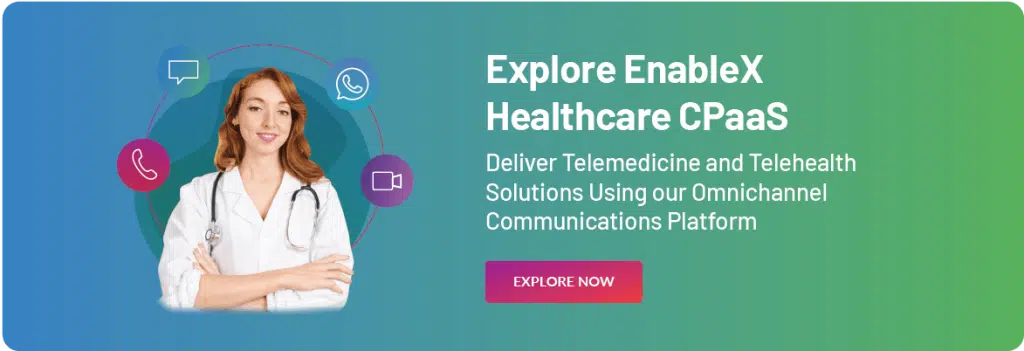Introduction
The healthcare landscape has undergone a remarkable transformation with the integration of telehealth services. Telehealth, the delivery of healthcare services remotely using technology, offers patients convenient access to medical consultations, diagnoses, and treatment plans. However, as telehealth gains popularity, it becomes imperative to address the crucial aspect of patient data security and privacy. In this blog, we delve into the world of telehealth within the framework of the Health Insurance Portability and Accountability Act (HIPAA) to ensure that healthcare providers and patients can confidently embrace this innovative approach to care.
As a healthcare or insurance organization looking into procuring video calling, SMS or other patient communications services in the United States, you need to look into multiple factors to ensure you are compliant with the HIPAA.
What is HIPAA?
HIPAA, enacted in 1996, is a landmark federal law designed to safeguard the privacy and security of patients’ healthcare information. It consists of two main rules relevant to telehealth: the Privacy Rule and the Security Rule. Let’s explore how these rules apply to telehealth.
1. The Privacy Rule: This rule dictates how healthcare providers, known as covered entities, should protect patients’ protected health information (PHI). PHI includes a patient’s medical history, treatment records, and any personally identifiable information (PII). Telehealth encounters are subject to the Privacy Rule, meaning that healthcare providers must ensure the confidentiality of patient data during remote consultations.
2. The Security Rule: While the Privacy Rule focuses on the protection of PHI, the Security Rule outlines the technical safeguards necessary to secure electronic PHI (ePHI). Telehealth relies heavily on electronic communication, making compliance with the Security Rule vital.
Risk Assessment: Covered entities must conduct regular risk assessments to identify vulnerabilities in their telehealth systems and implement appropriate safeguards.
Secure Technology: Telehealth platforms must employ secure technologies, including secure video conferencing, data encryption, and access control measures.
Training and Education: Staff members involved in telehealth must be well-versed in HIPAA compliance to prevent accidental breaches.

Requirements and Guidelines for HIPAA-Compliant Telehealth
- Patient Consent: Obtain informed consent from patients before initiating telehealth services, explaining how their data will be used and secured.
- Encryption: Employ end-to-end encryption for all telehealth communications to safeguard ePHI from interception or unauthorized access.
- Access Control: Implement strict access controls to limit access to ePHI to authorized individuals only.
- Business Associate Agreements (BAAs): Ensure that any third-party service providers, such as telehealth platform vendors, sign BAAs acknowledging their responsibility for protecting ePHI.
- Patient Access: Provide patients with access to their electronic health records through secure portals.
- Emergency Situations: In emergency telehealth situations, prioritize patient care and obtain consent for subsequent telehealth services.
Let’s examine each of these requirements against examples, especially related to video calling based workflows in healthcare:
Patient Consent
When providing telehealth services through video calls, covered healthcare providers must obtain informed consent from patients before initiating care. This consent should be in writing and should explain the following:
- The types of telehealth services that will be provided
- How the patient’s protected health information (PHI) will be used and secured
- The patient’s right to refuse telehealth services at any time
- Healthcare providers should also inform patients of the risks and benefits of telehealth services, such as the potential for technical difficulties or interruptions.
Example:
A healthcare provider is offering telehealth services through video calls for patients with chronic conditions. The provider provides patients with a written consent form that explains the following:
- The types of telehealth services that will be provided, such as video consultations, prescription renewals, and remote monitoring
- How the patient’s PHI will be used and secured, including the use of end-to-end encryption for all video calls
- The patient’s right to refuse telehealth services at any time
The provider also discusses the risks and benefits of telehealth services with the patient, such as the potential for technical difficulties or interruptions. The patient signs the consent form before the provider initiates the telehealth video call.
Encryption
End-to-end encryption is a security measure that encrypts data so that it can only be read by the sender and intended recipient. This is essential for protecting PHI during telehealth video calls.
When choosing a telehealth video calling platform such as EnableX, healthcare providers should ensure that the platform uses end-to-end encryption for all video calls. Healthcare providers should also enable all available encryption and privacy features on their own devices.
Example:
A healthcare provider is using a HIPAA-compliant telehealth platform to offer video consultations to patients. The platform uses end-to-end encryption for all video calls, and the provider has enabled all available encryption and privacy features on their computer.
When the patient joins the video call, their device and the provider’s device generate a unique encryption key. This key is used to encrypt all data that is transmitted during the video call, including audio, video, and chat messages.
Only the patient’s device and the provider’s device have access to the encryption key. This means that even if someone were to intercept the data that is transmitted during the video call, they would not be able to read it without the encryption key.

Access Control
Healthcare providers should implement strict access controls to limit access to ePHI to authorized individuals only. This includes controlling access to telehealth platforms, devices, and accounts.
Healthcare providers should also create and enforce policies and procedures for managing access to ePHI. These policies and procedures should cover topics such as user authentication, authorization, and auditing.
Example:
A healthcare provider has created a policy for managing access to their telehealth platform. The policy requires all users to have a unique username and password. The policy also requires users to change their passwords every 90 days.
The healthcare provider has also enabled two-factor authentication for all users. This means that in addition to entering their username and password, users must also enter a code from their mobile phone to log in. This message can be generated through SMS API, also provided by EnableX, or an authenticator application.
The healthcare provider also audits access to the telehealth platform to identify any suspicious activity.
Business Associate Agreements (BAAs)
When using a third-party telehealth platform, healthcare providers must enter into a BAA with the platform vendor. A BAA is a contract that outlines the responsibilities of each party for protecting PHI.
The BAA should specify the following:
- How the platform vendor will use and secure the PHI that is shared with them
- The platform vendor’s security measures
- The platform vendor’s breach notification procedures
Example:
A healthcare provider is using a third-party telehealth platform to offer video consultations to patients. The healthcare provider has entered into a BAA with the platform vendor.
The BAA specifies that the platform vendor will use the PHI that is shared with them to provide telehealth services to the healthcare provider’s patients. The BAA also outlines the platform vendor’s security measures, such as end-to-end encryption and user authentication.
The BAA also includes the platform vendor’s breach notification procedures. In the event of a breach, the platform vendor is required to notify the healthcare provider within 72 hours.
Patient Access
Healthcare providers should provide patients with access to their electronic health records (EHRs) through secure portals. This allows patients to view their medical history, lab results, and other important health information.
Healthcare providers should also provide patients with instructions on how to access their EHRs through the secure portal.
Benefits of HIPAA-Compliant Telehealth
1. Enhanced Patient Trust: Patients are more likely to use telehealth services when they trust that their personal health information is secure.
2. Legal Compliance: Complying with HIPAA reduces the risk of legal repercussions and penalties for healthcare providers.
3. Improved Healthcare Access: Telehealth expands access to healthcare services, especially for individuals in remote areas or with limited mobility.
4. Efficiency: Streamlined electronic records and secure communication make healthcare delivery more efficient.
Read FAQs on HIPAA and Telehealth
Challenges and Considerations
1. Platform Selection: Choose a telehealth platform that complies with HIPAA regulations to ensure security and privacy.
2. Data Storage: Properly store and manage ePHI, considering both security and accessibility.
3. Patient Education: Educate patients about the importance of privacy and security in telehealth.
4. State Regulations: Be aware of state-specific telehealth regulations that may differ from federal HIPAA guidelines.
Conclusion
Telehealth is revolutionizing the way healthcare is delivered, offering convenience and accessibility to patients. However, this convenience should not come at the cost of patient privacy and data security. HIPAA provides the necessary framework to ensure that telehealth services maintain the highest standards of privacy and security.
By adhering to HIPAA regulations, healthcare providers can confidently offer telehealth services while preserving patient trust and complying with the law. In this digital age, the fusion of healthcare and technology can thrive harmoniously, creating a brighter, more accessible future for healthcare delivery.
If you are looking to build video API based solutions for telehealth, or need to integrate SMS API for patient healthcare provider transactions, you can start a free trial account here.


